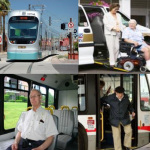Waiting for a Ride
Transit Access and America’s Aging Population
nevitably, aging experts note, a large share will find that their ability to navigate by vehicle diminishes or disappears over time. These millions of older adults will need affordable alternatives to driving alone in order to maintain their independence as long as possible.

Aging in Place, Stuck without Options:
Fixing the Mobility Crisis Threatening the Baby Boom Generation
The baby boom generation is the largest in U.S. history with more than 77 million people born between 1946 and 19641 Baby boomers are also unique because they came of age during the unprecedented economic expansion that followed World War II, which helped fuel the rise of new suburban communities and increased reliance on the private automobile. At the same time, the Federal Government initiated the largest infrastructure project in U.S. history with the construction of the Interstate Highway system. Whereas previous generations tended to live in close proximity to employment centers, new suburban housing developments required frequent, long-distance trips by automobile. With the support of substantial federal funding, metropolitan regions developed vast road networks to connect people to employment, healthcare, recreation, and friends and family. Automobiles became an essential component of daily life as opposed to a luxury.
Only a small percentage of Americans move after they reach retirement age, according to demographic researchers, meaning most will ―age in place‖ in neighborhoods where daily activities require frequent car trips. With rising life expectancies, America‘s largest generation also will be the oldest ever. Inevitably, aging experts note, a large share will find that their ability to navigate by vehicle diminishes or disappears over time. These millions of older adults will need affordable alternatives to driving alone in order to maintain their independence as long as possible.
Many seniors will rely on relatives or friends to take them around, and a smaller number will move to places where services and activities are close by. Pedestrian-friendly streets and recreational trails built with seniors in mind will help older Americans get around safely and remain active, regardless of where they live. But only adequate public transportation services can assure that older adults can travel as often or as far as they like, without worrying about inconveniencing others.
Absent access to affordable travel options, seniors face isolation, a reduced quality of life and possible economic hardship. A 2004 study found that seniors age 65 and older who no longer drive make 15 percent fewer trips to the doctor, 59 percent fewer trips to shop or eat out, and 65 percent fewer trips to visit friends and family, than drivers of the same age.2 A 2002 study in the American Journal of Public Health showed that men in their early seventies who stop driving are likely to continue to get around for an average additional six years with adequate travel options, such as public transportation; women in the same age group could maintain their mobility a full 10 years longer, on average. 3 A 2008 survey by AARP found that 85 percent of older Americans were either extremely concerned or very concerned about rising fuel prices, leading many to look toward other forms of transportation or to reduce their travel.4
________________________________________________
1 Coughlin, Joseph F. (2009) ―Longevity, Lifestyle, and Anticipating the New Demands of Aging on the Transportation System‖ Public Works Management & Policy Volume 13 Number 4 301-311
2 Bailey, Linda (2004) ―Aging Americans: Stranded without Options‖ Surface Transportation Policy Project, Washington, D.C.
3 Foley, Daniel, Heimovitz, Harley, Guralnik, Jack and Dwight Brock ―Driving Life Expectancy of Persons Aged 70 Years and Older in the United States,‖ American Journal of Public Health, August 2002, Vol 92, No. 8
4 Skufca, Laura. (2008) ―Is the Cost of Gas Causing Americans to Use Alternative Transportation?‖ AARP